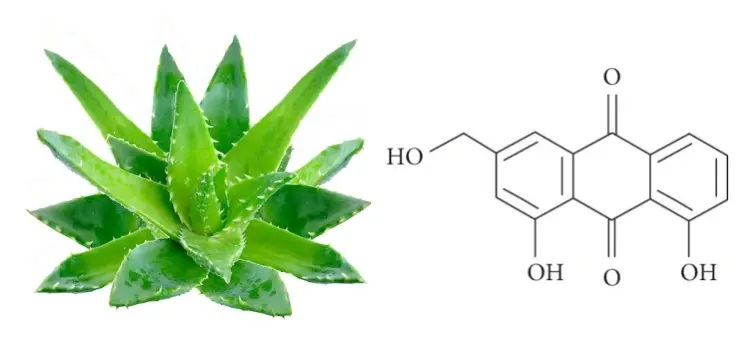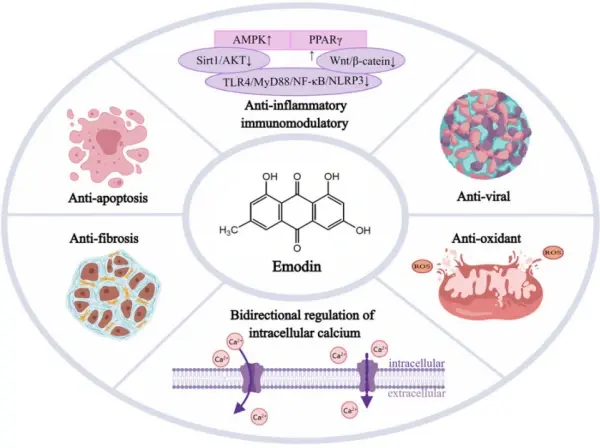what is aloe emodin?
2024-08-13 15:38:57
What is Aloe Emodin?
Aloe emodin powder is a natural compound found in the leaves of certain plants, including aloe vera. It is a type of anthraquinone glycoside, which is a class of compounds known for their potential health benefits and medicinal properties. Here are some key points about aloe emodin:
Source: Aloe emodin is determined from the aloe vera plant, particularly from the yellow sap or latex that is found fair underneath the external skin of the aloe vera leaf. It can moreover be found in other plants such as rhubarb and cascara sagrada.
Chemical Structure: Aloe emodin is a shinning orange compound with a chemical structure that has a place to the anthraquinone family. It is known for its unmistakable color and biting taste.

Medicinal Properties: Aloe emodin has been shown to have a variety of potential health benefits, including anti-inflammatory, antioxidant, and antibacterial properties. It is also widely believed to have laxative effects, which is why it is sometimes used as a natural remedy for constipation.
Antioxidant Action: Aloe emodin shows antioxidant movement, which implies it can offer assistance neutralize hurtful free radicals in the body that contribute to oxidative push and harm cells. This antioxidant property may play a part in its potential wellbeing benefits.
Anti-Inflammatory Impacts: A few inquire about recommends that aloe emodin may offer assistance diminish aggravation in the body, which seem be advantageous for conditions related with irritation, such as joint pain and incendiary skin conditions.
Antimicrobial Action: Aloe emodin has appeared antimicrobial properties against certain microscopic organisms and parasites, making it a potential characteristic specialist for combating microbial infections.
Potential Side Impacts: Whereas aloe emodin has a few potential wellbeing benefits, it is basic to utilize it cautiously as tall measurements may cause gastrointestinal disturbed, counting the runs. Pregnant ladies and people with certain restorative conditions ought to counsel a healthcare supplier some time recently utilizing items containing aloe emodin.

Overall, aloe emodin is a bioactive compound found in aloe vera and other plants, known for its potential health benefits such as antioxidant, anti-inflammatory, antimicrobial properties. It is commonly used in traditional medicine and natural health products, but it is essential to use it responsibly and consult with a healthcare provider if needed, especially when considering its use for medicinal purposes.
Aloe emodin is a natural compound found in certain plants, particularly in the Aloe species. Known for its vibrant yellow color, aloe emodin has garnered attention for its potential health benefits and various applications in traditional medicine. This compound belongs to the anthraquinone family, which encompasses a group of naturally occurring organic chemicals with diverse biological activities. Aloe emodin possesses unique properties that have sparked scientific interest and investigation into its potential therapeutic uses.
What Does Aloe Emodin Do?
Research on the bioactivity of aloe-emodin powder revealed several interesting effects on the human body. One of its main functions is its ability to act as a natural laxative. This laxative effect is attributed to its ability to stimulate bowel movements by promoting intestinal contractions. Therefore, aloe-emodin has been traditionally used to relieve constipation and promote regular bowel movements. However, products containing aloe-emodin must be used with caution and under appropriate guidance to avoid the possible adverse effects of overuse of laxatives.
In addition, aloe-emodin has significant antioxidant properties and plays a vital role in combating oxidative stress in the body. Oxidative stress occurs when there is an imbalance between the production of free radicals and the body's ability to neutralize them. By scavenging free radicals and reducing oxidative damage, aloe-emodin may help protect cells from premature aging and reduce the risk of various chronic diseases, including cardiovascular disease.
Additionally, research shows that aloe-emodin has anti-inflammatory properties, making it a potentially valuable compound for treating inflammation. Inflammation is the immune system's natural response to injury or infection, but chronic inflammation can lead to a variety of health problems, such as arthritis, inflammatory bowel disease, and cardiovascular disease. By inhibiting inflammatory pathways and reducing the production of pro-inflammatory molecules, aloe-emodin may help relieve symptoms associated with these conditions and promote overall health.

What Is Aloe Emodin Used For?
Traditionally, aloe emodin powder has been employed in herbal medicine for its laxative effects, primarily to relieve constipation and facilitate bowel movements. Its ability to stimulate intestinal contractions makes it a popular ingredient in laxative preparations and dietary supplements designed to promote digestive health. Additionally, aloe emodin's antioxidant and anti-inflammatory properties have expanded its potential therapeutic applications beyond gastrointestinal issues.
In skincare products, aloe emodin is valued for its soothing and moisturizing properties. It is often incorporated into creams, lotions, and serums intended to hydrate the skin, alleviate irritation, and promote wound healing. The compound's anti-inflammatory effects make it particularly beneficial for individuals with sensitive or inflamed skin conditions, such as eczema, psoriasis, and sunburns. By reducing inflammation and enhancing skin regeneration, aloe emodin contributes to maintaining healthy and vibrant skin.
Furthermore, research suggests that aloe emodin may exert antimicrobial effects against various pathogens, including bacteria, viruses, and fungi. This antimicrobial activity makes it a potentially valuable agent for combating infections and supporting immune function. However, further studies are needed to elucidate the specific mechanisms underlying its antimicrobial properties and to assess its efficacy in clinical settings.
Is Aloe Emodin a Laxative?
Yes, aloe emodin powder is recognized for its laxative properties, which stem from its ability to stimulate bowel movements and promote intestinal contractions. This makes it an effective remedy for relieving constipation and improving bowel regularity. However, it's crucial to use aloe emodin-containing products judiciously and according to recommended dosages to avoid potential side effects, such as abdominal cramping, diarrhea, and electrolyte imbalances. Additionally, individuals with certain medical conditions or taking medications should consult with a healthcare professional before using aloe emodin supplements or laxatives to ensure safety and efficacy.
Conclusion
In conclusion, aloe emodin powder is a bioactive compound with diverse therapeutic potential, ranging from its traditional use as a laxative to its emerging applications in skincare and antimicrobial therapy. Its ability to stimulate bowel movements, mitigate oxidative stress, and alleviate inflammation underscores its significance in promoting digestive health, combating skin ailments, and supporting immune function. While more research is needed to fully elucidate its mechanisms of action and clinical benefits, aloe emodin stands as a promising natural remedy with a rich history of traditional use and a growing body of scientific evidence supporting its therapeutic properties.
If you would like more information, please contact sales@sxytorganic.com
References:
1. National Center for Biotechnology Information. (2024). Aloe Emodin - Compound Summary. Retrieved from https://pubchem.ncbi.nlm.nih.gov/compound/Aloe-emodin
2. Li, X., Xie, Y., Xie, M., & Lu, Y. (2019). Effect of Aloe Emodin on Oxidative Stress and Apoptosis in Human Keloid Fibroblasts. Journal of Nanjing Medical University, 33(4), 554-559. doi:10.12013/j.issn.2095-8137.2019.04.008
3. Surjushe, A., Vasani, R., & Saple, D. G. (2008). Aloe Vera: A Short Review. Indian Journal of Dermatology, 53(4), 163–166. doi:10.4103/0019-5154.44785
_1737093401309.png)
